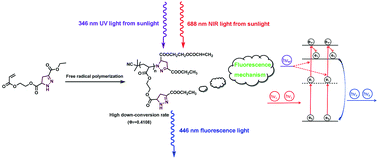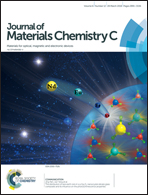Novel up-conversion photoluminescent materials: noncoherent excitation by near-infrared sunlight†
Abstract
Our synthesized oligomer (OCACP) can convert the near-infrared (NIR) region of sunlight into visible light with assistance from ultraviolet (UV) light, and the mechanism includes UV quantum cutting and NIR two-photon absorption. Here, we report a high conversion rate (ΦF = 0.4108) for a wavelength-focusing photoluminescent OCACP with densely grafted 2-pyrazoline that was prepared by free-radical polymerization of 3-carbethoxy-5-acrylatecarbethoxy-2-pyrazoline, a chromophore with good fluorescence (ΦF = 0.0171). After polymerization, the densely grafted 2-pyrazoline significantly increased the interaction between the pyrazoline ring and formed a propeller shape, and the intramolecular pyrazoline ring rotations were physically restricted, which restrained the non-radiative pathway and accelerated the radiative pathway. These factors collectively contributed to the excellent fluorescence performance of OCACP. Additionally, OCACP achieved good-quality live-cell imaging with an enhancement in the fluorescence intensity through two-wavelength excitation of the cell rather than increasing the dye dosage or laser power and improved the visible portion of sunlight for more efficient use of solar energy.



 Please wait while we load your content...
Please wait while we load your content...